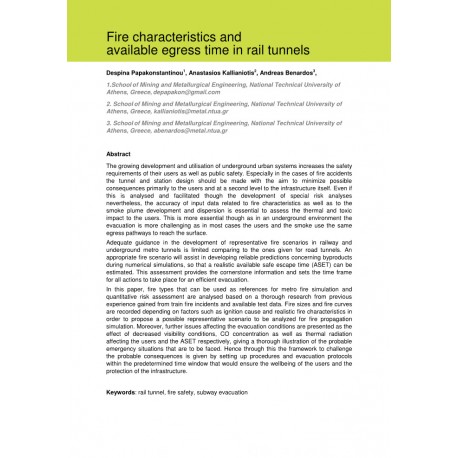Cart
0
0
No document
0,00 €
Total
Document successfully added to your shopping cart
Quantity
Total
There are 0 items in your cart.
There is 1 item in your cart.
Total documents
Total shipping
To be determined
Total
Search & filter
Search for a publication
Search & filter
Viewed documents

Fire characteristics and available egress time in rail tunnels
3053_fire_characteristics_and_av
A. Benardos / D. Papakonstantinou / A. Kallianiotis
The growing development and utilisation of underground urban systems increases the safety requirements of their users as well as public safety. Especially in the cases of fire accidents the tunnel and station design should be made with the aim to minimize possible consequences primarily to the users and at a second level to the infrastructure itself. Even if this is analysed and facilitated though the development of special risk analyses nevertheless, the accuracy of input data related to fire characteristics as well as to the smoke plume development and dispersion is essential to assess the thermal and toxic impact to the users. This is more essential though as in an underground environment the evacuation is more challenging as in most cases the users and the smoke use the same egress pathways to reach the surface. Adequate guidance in the development of representative fire scenarios in railway and underground metro tunnels is limited comparing to the ones given for road tunnels. An appropriate fire scenario will assist in developing reliable predictions concerning byproducts during numerical simulations, so that a realistic available safe escape time (ASET) can be estimated. This assessment provides the cornerstone information and sets the time frame for all actions to take place for an efficient evacuation. In this paper, fire types that can be used as references for metro fire simulation and quantitative risk assessment are analysed based on a thorough research from previous experience gained from train fire incidents and available test data. Fire sizes and fire curves are recorded depending on factors such as ignition cause and realistic fire characteristics in order to propose a possible representative scenario to be analyzed for fire propagation simulation. Moreover, further issues affecting the evacuation conditions are presented as the effect of decreased visibility conditions, CO concentration as well as thermal radiation affecting the users and the ASET respectively, giving a thorough illustration of the probable emergency situations that are to be faced. Hence through this the framework to challenge the probable consequences is given by setting up procedures and evacuation protocols within the predetermined time window that would ensure the wellbeing of the users and the protection of the infrastructure.


